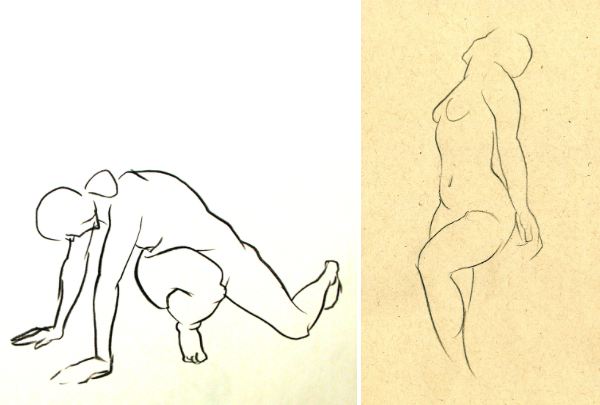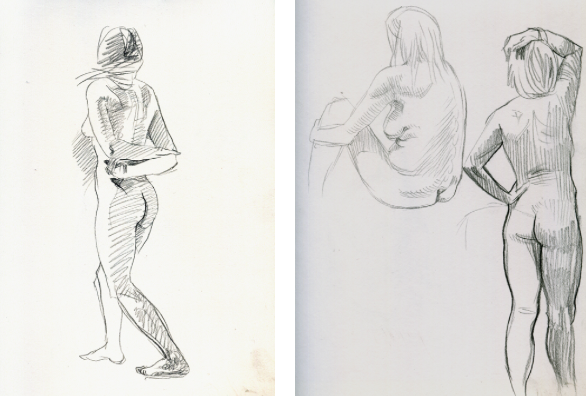Attending a figure drawing session is one of the best ways to learn how to draw. Figure drawing offers the chance to sharpen your observational acuity and hone your skills in a variety of media, all while working from a real live person. You can explore line, value, space and anatomy, all in one session. Best of all, you can also learn how to sketch quickly because poses last different lengths of time. Learning how to draw accurately in a short period of time is an important skill for any observational artist because it opens up a world of sketching opportunities.

Figure drawing comes in two different flavors: short poses—typically five minutes or less—and long poses—that can last up to several hours at a time.These different durations allow you to focus on different skills.
Many figure drawing sessions begin with a series of very short poses, ranging from 30 seconds to one minute. This is a great calisthenic exercise for warming up your drawing hand and eyes, and for thinking gesturally. A good tip to consider during these very short poses is not to worry about anatomy or light and shadow, but rather focus on the things you can sum up quickly in a fast, scribbly “gesture drawing.” Here, you want to capture very rough proportion and the model’s energy and movement. Plus, these quick poses allow the model to get in dynamic positions that are difficult to hold for long durations.
Gestural figure drawings, one minute apiece, 4B pencil:

For one minute gesture drawings like the above, try and establish as much of the shape and movement of the figure as you can in the time allotted. Some people draw stick figures that follow the curves and angles of the body, instead of the contours, just to capture the essence of the pose.
In two to five minute poses, you have a little more time to work on things like line quality, proportion, and briefly address light and dark. These two sketches emphasize line quality and the subtlety of the contours of the figure.

The figure on the left was drawn using vine charcoal, while the one on the right was done with a dark soft pencil (in the middle “B” range) on toned paper. A good tip for doing sketches like these is to let your hand follow your eye as it traces the contour of the figure. Where your eye moves, so should your hand. You can try varying line quality where the edge of the figure is more dynamic—try adding more line weight along the underside of curves in the figure to suggest the illusion of volume.
The five minute drawings below are starting to introduce value into the figure. As economically as possible, try scribbling the location of the shadows on the figure, and even those around the figure, which help to define its shape.

For poses longer than five minutes, allow yourself some time to establish and block out the rough proportions of the figure. Then try to introduce more value, and fine-tune the contours and proportions. Use different approaches to mark-making; hatched and scribbled lines in different densities can be used to describe dark values. The edge of a piece of charcoal, conte crayon, or even a sharpened pencil can also create effective dark tones without a scribbly quality. Beyond that, use the tip of your finger or a paper stump to soften and smooth out dark values laid out in charcoal or pencil.


Notice above how dark values in the negative space around the figure can also describe its form and shape. In the first image, even the dark values on the back serve as negative space to depict the model’s left arm.
For very long poses, toned paper is a great way to explore value in-depth. Many pastel and charcoal papers come in neutral shades that provide an intermediate value so you can use both light and dark media to sketch the figure. In the drawings below, the dark values are created with hatched ink lines, though conte, charcoal, pastel and pencil can also be used. The light values were created with a white gel pen, but any opaque light media will work well. Intermediate values within the figure can be created simply by leaving them alone.


Many communities have drop-in instructed and uninstructed life drawing sessions that allow you to draw the human figure on a regular basis. If you know someone willing to pose for you, you can draw from life anytime. And of course, the model does not have to be nude!
I’d love to know, have you been to a figure drawing session before? How will you explore figure drawing in the future?
You might also enjoy the history of portraiture and learning all about hues. Plus, come back to the Craftsy blog tomorrow for a look at an oil painting technique you’ll want to add to your repertoire.

Share tips, start a discussion or ask one of our experts or other students a question.
No Responses to “Figure Drawing Tips”